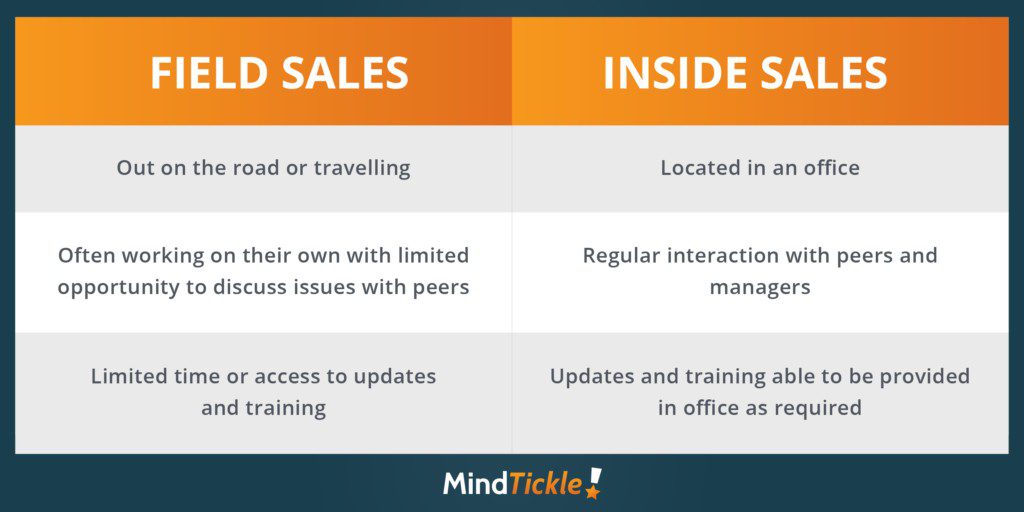How Field Sales Enablement Differs from Inside Sales Enablement
Sales Enablement needs of field reps are far more complex than that of inside sales teams. Inside teams are in close proximity to their managers and mentors. Field reps, more often than not, are left to their own devices to ensure their readiness to close a deal.

 Knowledge baselining and message calibration
Knowledge baselining and message calibration
For large events such as onboarding or a new product launch, businesses often prefer to interact in person so field reps are flown in, taking them away from valuable selling time at considerable expense. As inside teams are often located in the same place, these initiatives still require an investment of time, but it’s generally far less disruptive than for their field counterparts.
It’s one thing to fly reps in, but to then convey a large volume of information and expect them to digest it, take it back to the field and apply it is a big ask. The forgetting curve kicks in if there is not adequate reinforcement, which often means the new knowledge isn’t applied in sales conversations. As inside reps are in close contact with their peers and their manager, there is more opportunity for these issues to be identified and addressed quickly. That’s why it’s more important to consider how to make baselining and calibration more effective for field sales teams.
One way that’s proved to be effective, while also making use of the valuable time in the office, is to use a
flipped classroom
. This approach allows you to actually calibrate and get the reps on the message rather than just talking them through it from a lectern. Where it’s possible, like before a sales kickoff, you can even give them some pre-work so they already have some background knowledge before attending the sessions.
Refreshing
To overcome the forgetting curve refreshing is important for both field and inside sales reps, and the same techniques are effective for both teams. The main difference for field sales reps is that the way the information is reinforced needs to fit in with their work day. This is where leveraging technology that enables reinforcement initiatives to be mobile is helpful. The technologies can be applied just as readily to inside sales, which makes it more efficient for the sales enablement team as well.
Communication
Because field reps are often physically isolated from their colleagues and managers, communication plays a crucial role in their sales readiness. And when you’re communicating something you want to ensure that every update is applied to sales conversations in a consistent way across the region. Because sales managers can’t have these conversations in person with their field reps technology is the best bridge to meet this challenge. But before turning to technology, it’s important to have clarity on what type of behavior you’re hoping to achieve and how the information needs to be used by the reps, as this will dictate the design of your communication program.
For example, if your team’s win rate vis a vis a competitor is on the decline and you learn some new insights about the competitor that may be useful, you need to determine the most effective way to communicate this. One way could be to just tell them the information like “Competitor X has launched a new feature”. This disseminates the information but doesn’t help you understand or control how each of your reps uses the information.
Some effective ways that this could be communicated include videoing an example of how the information could be leveraged in a customer discussion. Alternatively, you could set a small mission for your reps, where they video how they would handle a customer objection using the competitor information. This provides you with a way to actually see how they apply the information and provide actionable feedback.
Another aspect that can be helpful is reverse communication. Again technology can be leveraged to poll reps to obtain their feedback on important issues. This can also increase engagement by giving them an opportunity to be heard.
Similarly, success stories are another great way to share information peer to peer. So if a rep in Boston has a big win they can make a short video explaining how they did it so reps in San Francisco can learn and use those special nuggets in their customer conversations.
Coaching and Accountability
Coaching is very challenging for managers of field sales teams, but it’s critical for reps to receive actionable feedback on their command of message and process. As managers aren’t able to monitor or see what their field reps are doing every day, technology is an important tool that can help them coach and evaluate performance effectively.
In many companies, sales enablement looks after organization-wide coaching and accountability initiatives, but there’s still a large role for sales managers in one on one coaching. For example, there may be local factors that influence customer conversations, such as a specific competitor, that require coaching on message. In these instances, technology allows managers to set localized missions to train their people. They may select a specific topic for a week and roll out a role play for the reps that it’s relevant to. The manager can then evaluate them and provide feedback at an individual level, even if they’re in a different city, state or country. It’s a powerful way to incrementally improve the performance of their team members and identify and address weaknesses before they become larger issues.


 Knowledge baselining and message calibration
Knowledge baselining and message calibration